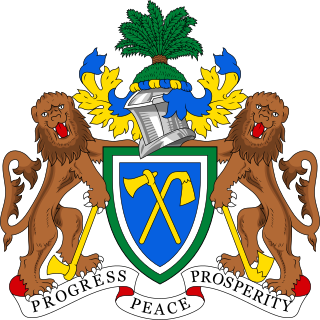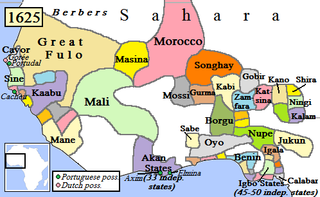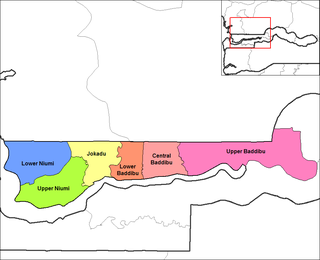The Kingdom of Saloum was a Serer/Wolof kingdom in present-day Senegal. Its kings may have been of Mandinka/Kaabu origin. The capital of Saloum was the city of Kahone. It was a sister kingdom of Sine. Their history, geography and culture were intricately linked and it was common to refer to them as the Sine-Saloum.

Albreda is a historic settlement in the Gambia on the north bank of the Gambia River, variously described as a 'trading post' or a 'slave fort'. It is located near Jufureh in the North Bank Division and an arch stands on the beach connecting the two places. As of 2008, it has an estimated population of 1,776.

Jufureh is a town in the Gambia, 30 kilometers inland on the north bank of the River Gambia in the North Bank Division near James Island. The town is home to a museum and Fort Jillifree.

Barra, traditionally known as Niumi, is a city in The Gambia, located in the district of Lower Niumi. The predominant languages of the city are Serer and Wolof.
Edrissa Sonko is a Gambian former professional football who played as a forward.

North Bank was one of the five administrative divisions of the Gambia. Its capital was Kerewan. It was subsequently reorganised as the Kerewan Local Government Area (LGA), without any change in the area covered.

Bignona is a town with commune status located in the Ziguinchor Region of Senegal (Casamance). It briefly appears in the movie Binta and the Great Idea.

The Gambia is subdivided into 43 districts. They are listed below by Local Government Area, each with its population at the 15 April 2013 census.

The Kaabu Empire (1537–1867), also written Gabu, Ngabou, and N'Gabu, was an empire in the Senegambia region centered within modern northeastern Guinea-Bissau, larger parts of today's Gambia; extending into Koussanar, Koumpentoum, regions of Southeastern Senegal, and Casamance in Senegal. The Kaabu Empire consisted of several languages, namely: Balanta, Jola-Fonyi, Mandinka, Mandjak, Mankanya, Noon (Serer-Noon), Pulaar, Serer, Soninke, and Wolof. It rose to prominence in the region thanks to its origins as a former imperial military province of the Mali Empire. After the decline of the Mali Empire, Kaabu became an independent Empire. Kansala, the imperial capital of Kaabu Empire, was annexed by Futa Jallon during the 19th century Fula jihads. However, Kaabu's successor states across Senegambia continued to thrive even after the fall of Kansala; this lasted until total incorporation of the remaining Kingdoms into the British Gambia, Portuguese and French spheres of influence during the Scramble for Africa.

Lower Niumi is one of the six districts of the North Bank Division of the Gambia. In the 2013 census, it had a population of 57,358.

Upper Niumi is one of the six districts of the North Bank Division of the Gambia which is located in West Africa The remaining five districts are: Lower Niumi, Jokadu, Lower Baddibu, Central Baddibu and Upper Baddibu.
Niumi National Park is a national park in The Gambia. The occupies the coastal strip in the northern region of the country, in the southern tip of the Sine-Saloum Delta. It covers an area of approximately 4,940 ha and encompasses a range of types of wetlands and vegetation, from freshwater marsh to sand spits and brackish lagoons. Rhizophora mangrove forest is abundant in the park, and its swamp and mudflats are an important sheltering ground for birds, with over 200 species found here.
The Niominka people are an ethnic group in Senegal living on the islands of the Saloum River delta. They are currently classified as a subgroup of the Serer.
The Palors also known as Serer-Palor, among other names, are an ethnic group found in Senegal around the west central, west southwest of Thiès. They are a sub-group of the Serer ethnic group found in Senegal, the Gambia and Mauritania. Although ethnically Serers, they do not speak the Serer language but one of the Cangin languages. Their language is Palor.

Noah Sonko Sundberg is a professional footballer who plays as a defender for Bulgarian First League club Levski Sofia. A former youth international for Sweden, he plays for the Gambia national team.
The military history of The Gambia spans from the earliest colonial contact in the 1500s through to the present day. Although it is currently one of the least militarized countries in the world, The Gambia has seen various colonial conflicts, and has contributed soldiers to Britain in World War I and World War II as part of the Gambia Regiment. Since independence in 1965, The Gambia has experienced various peacekeeping operations, as well as the 1994 military coup d'état and the 2017 ECOWAS military intervention.
The Barra War, also known as the Anglo-Niumi War or the British-Barra War, was a military conflict which lasted from 1831 to 1832 between forces of the British Empire and the Kingdom of Niumi, in what is now The Gambia.
The Kingdom of Niumi, also known as the Kingdom of Barra, was a West African nation at the Gambia River. Niumi was located at the mouth of the river, and extended nearly 60 kilometres (40 mi) along and north of its north bank. For much of its existence, its eastern border was occupied by the Kingdom of Baddibu, and its northern border was open savanna leading to Senegal. Formally becoming part of the Gambia Colony and Protectorate in 1897, the Kingdom now forms the Upper Niumi and Lower Niumi districts of the North Bank Division in The Gambia.
The Gambian Creole people, or Krio or Aku, are a minority ethnic group of Gambia with connections to and roots from the Sierra Leone Creole people. In Gambia the Aku account for about 2% of the population. Some estimates put the figure higher. However, according to the 2013 Gambian Census, the Aku make up 0.5% of the population or around 8,477 people.









